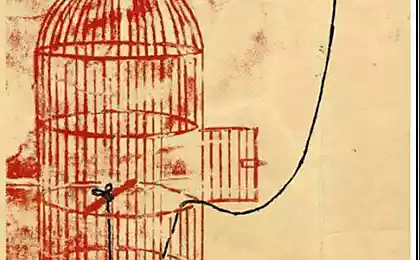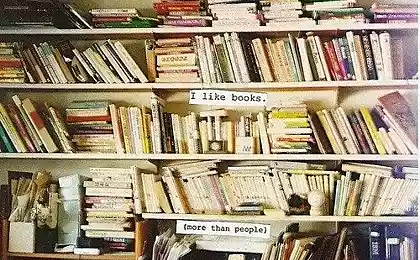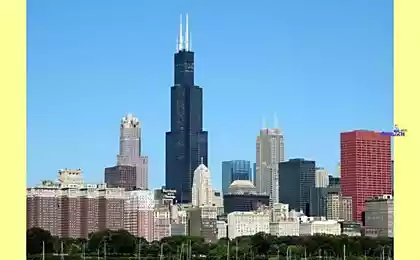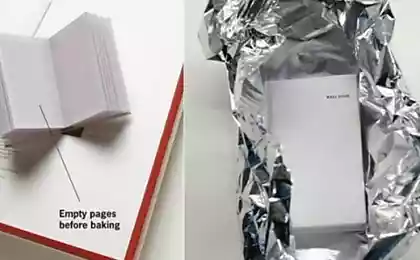2258
The Book of General Ignorance. Part 2 (30 pics)
The second part of the errors in the book Stephen Fry.
Part 1.
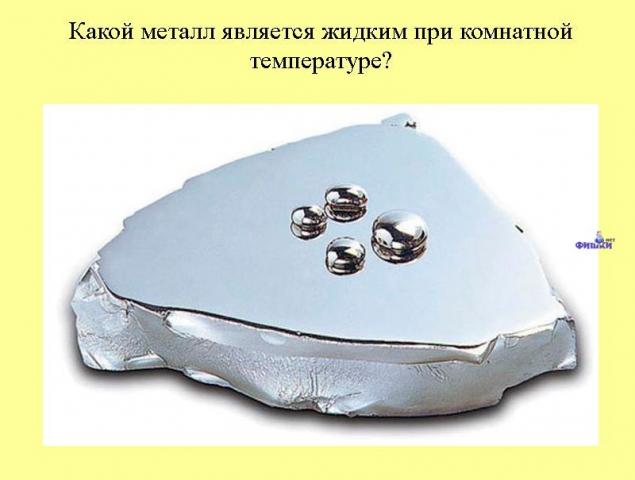
In addition to mercury, liquid at room temperature can also be gallium, cesium and francium. Since all of these very dense liquid (metals all), bricks, horseshoe and cannonballs theoretically will have to swim.
Gallium (Ga) was discovered in 1875 by French chemist by the name of Lecoq de Boisbaudran. All, of course, believed that the name of the new element inspired by purely patriotic reasons, but in fact the word gallus in Latin and "gal" ("French"), and "Rooster" - the same as the «Lecoq» (« Lecoq "). Gallium is the first chemical element that confirmed the predicted Dmitry Mendeleyev periodic table. Because of the unique electronic properties of gallium mainly used in silicon chips. It is also used in CD players, as a mixture with gallium arsenic transforms electric current into the laser beam, which "reads" the information from the disc surface.
The most notable area of application of cesium (Cs) - atomic clock. Where cesium is used to determine the atomic seconds. On contact with water, cesium is extremely intense blast. The word "Cs" means "sky-blue" - because of the bright blue lines in its spectrum. This phenomenon was first observed in 1860 by German scientist Robert Bunsen. Bunsen used a spectroscope, who invented together with Gustav Kirchhoff - man, proved that signals over telegraph wires pass the speed of light.
Frances (Fr) - one of the rare chemical elements, according to scientists on Earth, he is present in all of thirty grams. This is due to the fact that France is so radioactive that instantly dissolves, turning into other more stable elements. In general, the liquid metal, but not for long - a maximum of a couple of seconds. Frances was isolated in 1939 Marguerite Perret, who worked at the Institute Curie in Paris. He was the last element to be discovered in nature.
All of these chemicals are liquids at extremely low temperatures for metals because electrons in their atoms are arranged such that they are extremely difficult to approach each other and form a lattice.
Each atom is floating quite freely, not being attracted to the neighbors - a hair's breadth as well as in other body fluids.

Mission St. Bernard - a purely sober (not to mention the fact that the person giving the brandy with hypothermia - a terrible mistake), but the idea of tourists loved it, and because St. Bernards always pose a barrel, firmly attached to the collar.
Before these cute four-legged rescuers began to work, they actively used the shelter of the monks of St. Bernard Pass on the Great in the Alps - a mountain route connecting Switzerland and Italy. Dogs dragged on themselves provisions - large size and docile nature makes them perfect pack animals.
The idea of the notorious barrel visited the young English artist, Sir Edwin Lendsira (1802-1873), who enjoyed the favor of the Queen Victoria. Lendsir was known for his landscapes and depictions of animals, but most of all he was famous painting "Monarch of the Glen" and sculptures of lions at the foot of Nelson's Column in Trafalgar Square.
In 1831 Lendsir wrote canvas titled "Alpine Mastiffs bring to life a lost traveler," depicts two St. Bernards, one of whose neck hangs a barrel of brandy - that detail the artist added a "for fun." Since then, the label hung on all St. Bernards. Lendsiru also credited with popularizing the name of this breed - the "Saint Bernard" (instead of "alpine mastiff»).
Originally the breed was called "Barry" - distorted by the German Baren, «Bears." One of the first rescuers known as "Barry Great": the period from 1800 to 1814 the famous St. Bernard rescued forty people, but unfortunately, died at the hands of forty-one, who mistook him for a wolf.
After the death of Barry made a scarecrow, and today it proudly on display at the Natural History Museum in Berne. In honor of the greatest of rescuers best puppy-boy in each new litter at St. Bernard named Barry certainly.
Sometimes the sacred duty to ensure that the suffering and the blood has a table for shelter occupation is quite troublesome. So, one evening in 1708 his brother Vincent Kamo had once fed 400 travelers. To save labor, he fashioned like a large squirrel cage device attached to the skewer. Inside the wheel, rotating skewer with meat, one of the charity rysil St. Bernards.
According to some reports, since 1800 more than 2,500 dogs rescued travelers; however, no one - in the last fifty years. As a result, the monks decided to sell four-legged friends, replacing them with helicopters.

Albanian pig.
Albanian dogs do "ham-ham».
In Catalonia, the dogs bark "bap-bap." The Chinese say, "wang-wang," the Greek - "bow-wow", Slovenia - "Hov-Hov," Ukrainian - "Gath-GAF." In Iceland, a "voff" in Indonesia - "gong gong" and in Italian - "Dioulasso».
Interestingly, the less variation in the sound produced by the animal or otherwise, the more readily converge different languages in its interpretation. Thus, in almost every language of the cow moos "mu", myauchit cat "meow" and cuckoo cuckoo "Cuckoo».
According to scientists from the Centre for the Study of animal behavior in Cumbria, the dogs even become a local accent. Most obviously, he pronounced in the Liverpool Scottish and pets. In liverpultsev voice a little higher, but the Scots' lighter tone ».
To gather the necessary data specialists of the Center appealed to the owners and their pets with a request to leave a voice message on the answering machine, and then compared the height, tone, volume and length of the sounds emitted by a dog and a man.
As a result, scientists have concluded that the dogs imitate the voices of the hosts, in order to demonstrate their affection: the more it is stronger, the greater the similarity in sound.
In addition, dog owners tend to copy the behavior. For example, the terrier, who lives in a family of young people, is likely to be an energetic and rebellious. But the same dog, got to the hostess-old woman turns to a quiet and passive creature, prone to long periods of sleep.

No. And certainly not "Ribby».
A three-foot goliath frog from Central Africa - dumb.
To date, 4360 is known species of frogs, but only one of them shouting "Ribby". Each individual your own unique cry. The reason that we believe that all frogs say "Ribby," is that "Ribby" - the sound characteristic of the Pacific tree frog (Hyla regilla). It is this frog lives in Hollywood.
Recorded in the field of natural habitat is the croaking of several decades accompanies the films "dream factory" - to impart flavor to anything, just all in a row - from the swamps of Florida to the Vietnamese jungle.
Frogs emit a variety of sounds. They croak, snore, grunt, trill, klohchut, tweeting, rings, uhayut, hiss and grumble. They can produce sounds reminiscent voice cow proteins, or cricket. Barking tree frog yelps like a dog; Frog carpenter pounding the two carpenter nails clogging piecemeal; Fowler's toad emits a sound like the bleating of sheep suffering from severe cold. South American paradoxical frog (Pseudis paradoxa) all grunts like a pig (and it is paradoxical because its tadpoles three times larger than the mother).
The female frogs mostly silent. And all so familiar hubbub created males who advertise themselves to potential spouses. The loudest frog in the world - a tiny coca (coqui) of Puerto Rico; its Latin name, Eleutherodactylus coqui, the body length of the screamers. Males gather in coca-dense forests - one to ten square meters - and compete with each other, who will issue the loudest cry. At a distance of a meter the power produced croaking comes to ninety-five decibels - about the same as from a jackhammer, and very close to the human pain threshold.
Recent studies have finally helped to unravel the mystery of how when a force croaking frog do not burst eardrums. It turns out, listening to the frogs using light. By absorbing the vibrations, light line the internal and external pressure on the surface of the membrane, protecting the sensitive inner ear frog.
The principle of frogs quack similar to the principle of radio stations: each type chooses its own frequency. Therefore, everything that we hear from you - the forest or the neighborhood of the pond, filled with discordant competing tree frog - almost distracting frogs ladies who set up solely on the sounds produced by the males of the same species.
Internationally accepted that frog sounds most like a duck quacking. But not everywhere. In Thailand, for example, the frog says "on-on" in Poland - "kam-kam" in Argentina - "bёrp"; Algerian emit sound "Har har," similar to the Chinese "GTO, GTO"; Bengal say "Gangora-Gangora"; Hindi - "ME: to: ME: to-me: to: ME: to the" (colon here means that the previous vowel sound - a long and pronounced nose); Japanese shouting "keroke-ro" and Korean - 'ge-ge-hum-hum ».

William Shakespeare first used the phrase "at-hee, y xy" in the poem "Winter", the final play "Love's Labour's Lost" (1595): Charter of the eyes, the owl cries: I-hu! In-hee, y xy! - Sings, it sounds; At Jenny oily soup boils.
(Translation MA Kuzmin.)
None of the owl in the world has never cried "at-hee-hoo moment».
Barn Owl squeal. Marsh is very silent. A drawn-eared issue and low "oo-oo-oo».
The sound is most reminiscent of Shakespeare's "at-hee, y xy" produce ordinary scouts. And two.
Male - also known as "brown owl" - calling uhayuschim "huuu-huuu-huuu" and the female responds husky "ki-vik».

El - though only once.
Charles Darwin motivated not so much scientific as gastronomic curiosity. Back in Cambridge, where the future scientist without much enthusiasm he studied theology, Darwin became a member of the "Club of gluttons" (or, if you like, "gourmet") meets once a week and are actively seeking to eating animals, which do not include the regular restaurant menu.
His son Francis, commenting on the letters of his father, noted that "foodies", among other things, especially complained bitterns and a hawk, but all of their "zeal and diligence were broken on the old brown owl" (aka - tawny owl), which consumers described as "indescribable».
Over the years, Darwin considerably raised its weight in the arena of academic and lost faith in the Lord, but in any case not lose attachment to the original menu.
For example, while traveling on the "Beagle" he ate armadillo, which, in his own words, "the taste and appearance were almost like a duck," and rodent color of chocolate - "the best of all types of meat, that I have ever I tried. " Apparently, it was a golden hare agouti, a spokesman for the family Dasyproctiade (in Greek - "hairy ass"). In Patagonia Darwin appetite umyal bowl with stew puma (cougar, Felis concolor), and decided that the taste of the dish is strongly reminiscent of veal. In fact, at first he really thought that eating veal.
Later, in 1833, searched the entire Patagonia in search of a rare species of rhea, Darwin suddenly realized that he had already eaten one such for Christmas dinner when the ship was on the quay close to the harbor of Port-Dizayr. Bird shot Martin Conrad, the ship's artist.
Darwin thought it was one of the common rhea - or "ostrich", as he simply called them - and realized his mistake only when the cymbals was almost nothing left. "Everything was cooked and eaten before I had time to recover. Fortunately, head, neck, legs, wings, most of the large feathers and a large part of the skin was able to save. " Darwin rushed balances Zoological Society of London - and Rhea Darwini (Darwin's Rhea) was named after the great scientist.
On the Galapagos Islands, Darwin ate iguanas (Conolophus subcristatus), and on the island of James enthusiastically threw a few servings of Galápagos tortoise. Still not realizing the importance of turtles for their future evolution theory, the scientist told load on the "Beagle" Forty-eight individuals. All the way home to Darwin and his comrades with pleasure knead prey, throwing the empty shells overboard.
In honor of the birth of Darwin on February 12 every year biologists organize so-called "Filumena-feast" - a joint meal is eaten during which as much as possible a variety of species of wildlife.

By the seventeenth century, you say? It's about the plague: the ring of roses - lesions on the skin, the first signs of infection; a bottle with a boutonniere - a futile attempt to scare the disease; sneezing - a symptom of impending disease; "Everything fell" - death.
Like most attempts to ascribe a precise historic significance of nursery rhymes and rhymes, this just does not hold water. For the first time this theory tried to promote a popular novelist James Lizor in a pretty bright statement of London life of the XVII century called "The Plague and Fire" (1961). I must say, so far there is no clear obvious connection (and there was absolutely no evidence) that the poem is sung in this form supposedly already 400 years old and supposedly as a way to save memory in the human plague inflicted injury.
Yes, because it is not. The earliest recorded version of the famous nursery rhyme dates back to 1790 and comes from Massachusetts: Ring a ring a rosie A bottle full of posie, All the girls in our town Ring for little Josie (Roses, roses - red color, lush, we Narva bouquet. In general, light scarlet roses Lovelier Josie not (translation Helena Poletskikh).).
There are French, German and even Gaelic versions. Some have a second verse, where all stand up again; other mention of wedding bells, buckets of water, birds, bell tower, Jack, Jill, and other images of familiar nursery rhymes and schitalochek.
Another, somewhat more plausible theory links the poem to the popular game in which all the participants stand in a circle: the main element of "holiday game" that emerged in the XVIII century in the Protestant communities in England and America, where dances were strictly prohibited.
«Ring-a-ring o'roses» and still remains the favorite "group play" in the UK.
In his book "nursery rhymes and fairy tales" (1924) by Henry Bette is of the opinion that the age of the poem should be "measured thousands of years, or rather the poem is so great that it simply can not be measured by anything».

«Drink, drink. Fan, fan. Rub, rub »(« To drink, drink. Masha, Masha. The three-three "(Eng.).).
That these were the last words uttered by the dying admiral. He was hot and very thirsty. Stewart stood by fanning Nelson fan and brings it to his lips wounded diluted lemonade wine, while the ship's chaplain, Dr. Scott massaged his chest Admiral, in order to ease the pain.
Most historians are sure that the dying said, «Kiss me, Hardy» («Kiss me, Hardy") - unlike some others, offering more noble «Kismet» (ie, "rock", "fate"). Witnesses testified that Vice-Admiral Nelson Hardy kissed twice - once on the cheek and once on the forehead - as he struggled to stay conscious.
Nelson asked his flagship captain did not throw his body overboard and take care of the "poor Lady Hamilton." Then uttered his immortal words. When Hardy kissed the team for the first time, he said: «Now I am satisfied» («Now I am satisfied"). Another second later: «Who is that?» («Who is this?"). When Nelson saw that it was Hardy, then croaked: «God bless you, Hardy» («The Lord bless you, Hardy"). Soon after that, he muttered: «Thank God I have done my duty» («Thank God I have done my duty"), and then: "Drink, drink. Masha, Masha. Three-three. " Admiral lost consciousness, call a doctor, and at 16:30 the Lord Nelson was officially declared dead.
It seems that Nelson deliberately decided to die at the moment of his triumph at Trafalgar. In guinea apiece Admiral bought four large silver stars and told her to sew his uniform next to a brilliant Neapolitan Order of St. Ferdinand. After that he stood in the middle of the deck "Victoria" and stood up as long as some French sniper shot him from fifteen meters.
It was a complete victory. And while the British lost 1,700 killed and wounded sailors, the British fleet did not lose a single ship. That is not true of the French and Spanish: their fleets were completely destroyed, 6,000 people were wounded or killed, 20,000 captured. Danger invasion of Britain was over. Immortality of Nelson - guaranteed.
During the return voyage from the Cape of Trafalgar, Admiral body preserved by immersing in a barrel of brandy.
e.
Part 1.

In addition to mercury, liquid at room temperature can also be gallium, cesium and francium. Since all of these very dense liquid (metals all), bricks, horseshoe and cannonballs theoretically will have to swim.
Gallium (Ga) was discovered in 1875 by French chemist by the name of Lecoq de Boisbaudran. All, of course, believed that the name of the new element inspired by purely patriotic reasons, but in fact the word gallus in Latin and "gal" ("French"), and "Rooster" - the same as the «Lecoq» (« Lecoq "). Gallium is the first chemical element that confirmed the predicted Dmitry Mendeleyev periodic table. Because of the unique electronic properties of gallium mainly used in silicon chips. It is also used in CD players, as a mixture with gallium arsenic transforms electric current into the laser beam, which "reads" the information from the disc surface.
The most notable area of application of cesium (Cs) - atomic clock. Where cesium is used to determine the atomic seconds. On contact with water, cesium is extremely intense blast. The word "Cs" means "sky-blue" - because of the bright blue lines in its spectrum. This phenomenon was first observed in 1860 by German scientist Robert Bunsen. Bunsen used a spectroscope, who invented together with Gustav Kirchhoff - man, proved that signals over telegraph wires pass the speed of light.
Frances (Fr) - one of the rare chemical elements, according to scientists on Earth, he is present in all of thirty grams. This is due to the fact that France is so radioactive that instantly dissolves, turning into other more stable elements. In general, the liquid metal, but not for long - a maximum of a couple of seconds. Frances was isolated in 1939 Marguerite Perret, who worked at the Institute Curie in Paris. He was the last element to be discovered in nature.
All of these chemicals are liquids at extremely low temperatures for metals because electrons in their atoms are arranged such that they are extremely difficult to approach each other and form a lattice.
Each atom is floating quite freely, not being attracted to the neighbors - a hair's breadth as well as in other body fluids.

Mission St. Bernard - a purely sober (not to mention the fact that the person giving the brandy with hypothermia - a terrible mistake), but the idea of tourists loved it, and because St. Bernards always pose a barrel, firmly attached to the collar.
Before these cute four-legged rescuers began to work, they actively used the shelter of the monks of St. Bernard Pass on the Great in the Alps - a mountain route connecting Switzerland and Italy. Dogs dragged on themselves provisions - large size and docile nature makes them perfect pack animals.
The idea of the notorious barrel visited the young English artist, Sir Edwin Lendsira (1802-1873), who enjoyed the favor of the Queen Victoria. Lendsir was known for his landscapes and depictions of animals, but most of all he was famous painting "Monarch of the Glen" and sculptures of lions at the foot of Nelson's Column in Trafalgar Square.
In 1831 Lendsir wrote canvas titled "Alpine Mastiffs bring to life a lost traveler," depicts two St. Bernards, one of whose neck hangs a barrel of brandy - that detail the artist added a "for fun." Since then, the label hung on all St. Bernards. Lendsiru also credited with popularizing the name of this breed - the "Saint Bernard" (instead of "alpine mastiff»).
Originally the breed was called "Barry" - distorted by the German Baren, «Bears." One of the first rescuers known as "Barry Great": the period from 1800 to 1814 the famous St. Bernard rescued forty people, but unfortunately, died at the hands of forty-one, who mistook him for a wolf.
After the death of Barry made a scarecrow, and today it proudly on display at the Natural History Museum in Berne. In honor of the greatest of rescuers best puppy-boy in each new litter at St. Bernard named Barry certainly.
Sometimes the sacred duty to ensure that the suffering and the blood has a table for shelter occupation is quite troublesome. So, one evening in 1708 his brother Vincent Kamo had once fed 400 travelers. To save labor, he fashioned like a large squirrel cage device attached to the skewer. Inside the wheel, rotating skewer with meat, one of the charity rysil St. Bernards.
According to some reports, since 1800 more than 2,500 dogs rescued travelers; however, no one - in the last fifty years. As a result, the monks decided to sell four-legged friends, replacing them with helicopters.

Albanian pig.
Albanian dogs do "ham-ham».
In Catalonia, the dogs bark "bap-bap." The Chinese say, "wang-wang," the Greek - "bow-wow", Slovenia - "Hov-Hov," Ukrainian - "Gath-GAF." In Iceland, a "voff" in Indonesia - "gong gong" and in Italian - "Dioulasso».
Interestingly, the less variation in the sound produced by the animal or otherwise, the more readily converge different languages in its interpretation. Thus, in almost every language of the cow moos "mu", myauchit cat "meow" and cuckoo cuckoo "Cuckoo».
According to scientists from the Centre for the Study of animal behavior in Cumbria, the dogs even become a local accent. Most obviously, he pronounced in the Liverpool Scottish and pets. In liverpultsev voice a little higher, but the Scots' lighter tone ».
To gather the necessary data specialists of the Center appealed to the owners and their pets with a request to leave a voice message on the answering machine, and then compared the height, tone, volume and length of the sounds emitted by a dog and a man.
As a result, scientists have concluded that the dogs imitate the voices of the hosts, in order to demonstrate their affection: the more it is stronger, the greater the similarity in sound.
In addition, dog owners tend to copy the behavior. For example, the terrier, who lives in a family of young people, is likely to be an energetic and rebellious. But the same dog, got to the hostess-old woman turns to a quiet and passive creature, prone to long periods of sleep.

No. And certainly not "Ribby».
A three-foot goliath frog from Central Africa - dumb.
To date, 4360 is known species of frogs, but only one of them shouting "Ribby". Each individual your own unique cry. The reason that we believe that all frogs say "Ribby," is that "Ribby" - the sound characteristic of the Pacific tree frog (Hyla regilla). It is this frog lives in Hollywood.
Recorded in the field of natural habitat is the croaking of several decades accompanies the films "dream factory" - to impart flavor to anything, just all in a row - from the swamps of Florida to the Vietnamese jungle.
Frogs emit a variety of sounds. They croak, snore, grunt, trill, klohchut, tweeting, rings, uhayut, hiss and grumble. They can produce sounds reminiscent voice cow proteins, or cricket. Barking tree frog yelps like a dog; Frog carpenter pounding the two carpenter nails clogging piecemeal; Fowler's toad emits a sound like the bleating of sheep suffering from severe cold. South American paradoxical frog (Pseudis paradoxa) all grunts like a pig (and it is paradoxical because its tadpoles three times larger than the mother).
The female frogs mostly silent. And all so familiar hubbub created males who advertise themselves to potential spouses. The loudest frog in the world - a tiny coca (coqui) of Puerto Rico; its Latin name, Eleutherodactylus coqui, the body length of the screamers. Males gather in coca-dense forests - one to ten square meters - and compete with each other, who will issue the loudest cry. At a distance of a meter the power produced croaking comes to ninety-five decibels - about the same as from a jackhammer, and very close to the human pain threshold.
Recent studies have finally helped to unravel the mystery of how when a force croaking frog do not burst eardrums. It turns out, listening to the frogs using light. By absorbing the vibrations, light line the internal and external pressure on the surface of the membrane, protecting the sensitive inner ear frog.
The principle of frogs quack similar to the principle of radio stations: each type chooses its own frequency. Therefore, everything that we hear from you - the forest or the neighborhood of the pond, filled with discordant competing tree frog - almost distracting frogs ladies who set up solely on the sounds produced by the males of the same species.
Internationally accepted that frog sounds most like a duck quacking. But not everywhere. In Thailand, for example, the frog says "on-on" in Poland - "kam-kam" in Argentina - "bёrp"; Algerian emit sound "Har har," similar to the Chinese "GTO, GTO"; Bengal say "Gangora-Gangora"; Hindi - "ME: to: ME: to-me: to: ME: to the" (colon here means that the previous vowel sound - a long and pronounced nose); Japanese shouting "keroke-ro" and Korean - 'ge-ge-hum-hum ».

William Shakespeare first used the phrase "at-hee, y xy" in the poem "Winter", the final play "Love's Labour's Lost" (1595): Charter of the eyes, the owl cries: I-hu! In-hee, y xy! - Sings, it sounds; At Jenny oily soup boils.
(Translation MA Kuzmin.)
None of the owl in the world has never cried "at-hee-hoo moment».
Barn Owl squeal. Marsh is very silent. A drawn-eared issue and low "oo-oo-oo».
The sound is most reminiscent of Shakespeare's "at-hee, y xy" produce ordinary scouts. And two.
Male - also known as "brown owl" - calling uhayuschim "huuu-huuu-huuu" and the female responds husky "ki-vik».

El - though only once.
Charles Darwin motivated not so much scientific as gastronomic curiosity. Back in Cambridge, where the future scientist without much enthusiasm he studied theology, Darwin became a member of the "Club of gluttons" (or, if you like, "gourmet") meets once a week and are actively seeking to eating animals, which do not include the regular restaurant menu.
His son Francis, commenting on the letters of his father, noted that "foodies", among other things, especially complained bitterns and a hawk, but all of their "zeal and diligence were broken on the old brown owl" (aka - tawny owl), which consumers described as "indescribable».
Over the years, Darwin considerably raised its weight in the arena of academic and lost faith in the Lord, but in any case not lose attachment to the original menu.
For example, while traveling on the "Beagle" he ate armadillo, which, in his own words, "the taste and appearance were almost like a duck," and rodent color of chocolate - "the best of all types of meat, that I have ever I tried. " Apparently, it was a golden hare agouti, a spokesman for the family Dasyproctiade (in Greek - "hairy ass"). In Patagonia Darwin appetite umyal bowl with stew puma (cougar, Felis concolor), and decided that the taste of the dish is strongly reminiscent of veal. In fact, at first he really thought that eating veal.
Later, in 1833, searched the entire Patagonia in search of a rare species of rhea, Darwin suddenly realized that he had already eaten one such for Christmas dinner when the ship was on the quay close to the harbor of Port-Dizayr. Bird shot Martin Conrad, the ship's artist.
Darwin thought it was one of the common rhea - or "ostrich", as he simply called them - and realized his mistake only when the cymbals was almost nothing left. "Everything was cooked and eaten before I had time to recover. Fortunately, head, neck, legs, wings, most of the large feathers and a large part of the skin was able to save. " Darwin rushed balances Zoological Society of London - and Rhea Darwini (Darwin's Rhea) was named after the great scientist.
On the Galapagos Islands, Darwin ate iguanas (Conolophus subcristatus), and on the island of James enthusiastically threw a few servings of Galápagos tortoise. Still not realizing the importance of turtles for their future evolution theory, the scientist told load on the "Beagle" Forty-eight individuals. All the way home to Darwin and his comrades with pleasure knead prey, throwing the empty shells overboard.
In honor of the birth of Darwin on February 12 every year biologists organize so-called "Filumena-feast" - a joint meal is eaten during which as much as possible a variety of species of wildlife.

By the seventeenth century, you say? It's about the plague: the ring of roses - lesions on the skin, the first signs of infection; a bottle with a boutonniere - a futile attempt to scare the disease; sneezing - a symptom of impending disease; "Everything fell" - death.
Like most attempts to ascribe a precise historic significance of nursery rhymes and rhymes, this just does not hold water. For the first time this theory tried to promote a popular novelist James Lizor in a pretty bright statement of London life of the XVII century called "The Plague and Fire" (1961). I must say, so far there is no clear obvious connection (and there was absolutely no evidence) that the poem is sung in this form supposedly already 400 years old and supposedly as a way to save memory in the human plague inflicted injury.
Yes, because it is not. The earliest recorded version of the famous nursery rhyme dates back to 1790 and comes from Massachusetts: Ring a ring a rosie A bottle full of posie, All the girls in our town Ring for little Josie (Roses, roses - red color, lush, we Narva bouquet. In general, light scarlet roses Lovelier Josie not (translation Helena Poletskikh).).
There are French, German and even Gaelic versions. Some have a second verse, where all stand up again; other mention of wedding bells, buckets of water, birds, bell tower, Jack, Jill, and other images of familiar nursery rhymes and schitalochek.
Another, somewhat more plausible theory links the poem to the popular game in which all the participants stand in a circle: the main element of "holiday game" that emerged in the XVIII century in the Protestant communities in England and America, where dances were strictly prohibited.
«Ring-a-ring o'roses» and still remains the favorite "group play" in the UK.
In his book "nursery rhymes and fairy tales" (1924) by Henry Bette is of the opinion that the age of the poem should be "measured thousands of years, or rather the poem is so great that it simply can not be measured by anything».

«Drink, drink. Fan, fan. Rub, rub »(« To drink, drink. Masha, Masha. The three-three "(Eng.).).
That these were the last words uttered by the dying admiral. He was hot and very thirsty. Stewart stood by fanning Nelson fan and brings it to his lips wounded diluted lemonade wine, while the ship's chaplain, Dr. Scott massaged his chest Admiral, in order to ease the pain.
Most historians are sure that the dying said, «Kiss me, Hardy» («Kiss me, Hardy") - unlike some others, offering more noble «Kismet» (ie, "rock", "fate"). Witnesses testified that Vice-Admiral Nelson Hardy kissed twice - once on the cheek and once on the forehead - as he struggled to stay conscious.
Nelson asked his flagship captain did not throw his body overboard and take care of the "poor Lady Hamilton." Then uttered his immortal words. When Hardy kissed the team for the first time, he said: «Now I am satisfied» («Now I am satisfied"). Another second later: «Who is that?» («Who is this?"). When Nelson saw that it was Hardy, then croaked: «God bless you, Hardy» («The Lord bless you, Hardy"). Soon after that, he muttered: «Thank God I have done my duty» («Thank God I have done my duty"), and then: "Drink, drink. Masha, Masha. Three-three. " Admiral lost consciousness, call a doctor, and at 16:30 the Lord Nelson was officially declared dead.
It seems that Nelson deliberately decided to die at the moment of his triumph at Trafalgar. In guinea apiece Admiral bought four large silver stars and told her to sew his uniform next to a brilliant Neapolitan Order of St. Ferdinand. After that he stood in the middle of the deck "Victoria" and stood up as long as some French sniper shot him from fifteen meters.
It was a complete victory. And while the British lost 1,700 killed and wounded sailors, the British fleet did not lose a single ship. That is not true of the French and Spanish: their fleets were completely destroyed, 6,000 people were wounded or killed, 20,000 captured. Danger invasion of Britain was over. Immortality of Nelson - guaranteed.
During the return voyage from the Cape of Trafalgar, Admiral body preserved by immersing in a barrel of brandy.
e.


